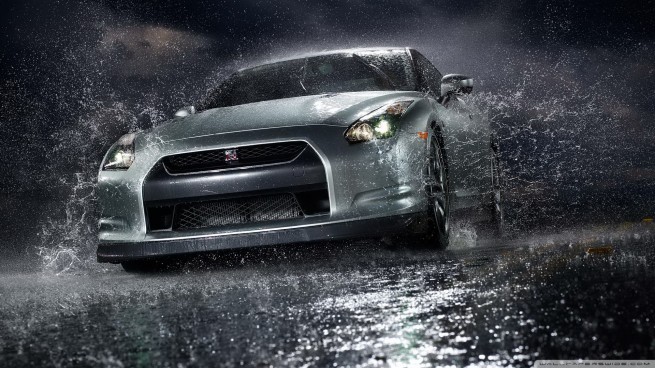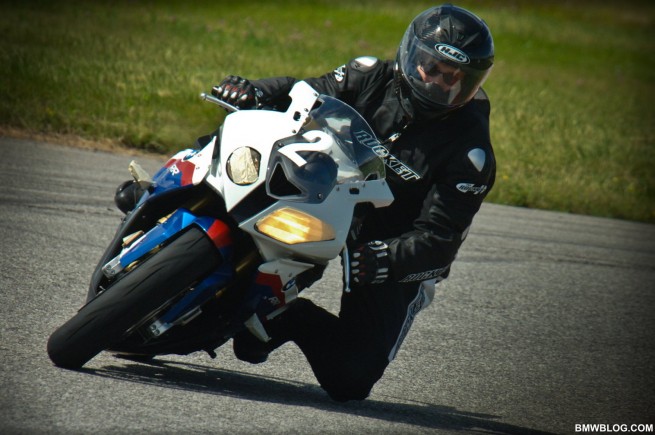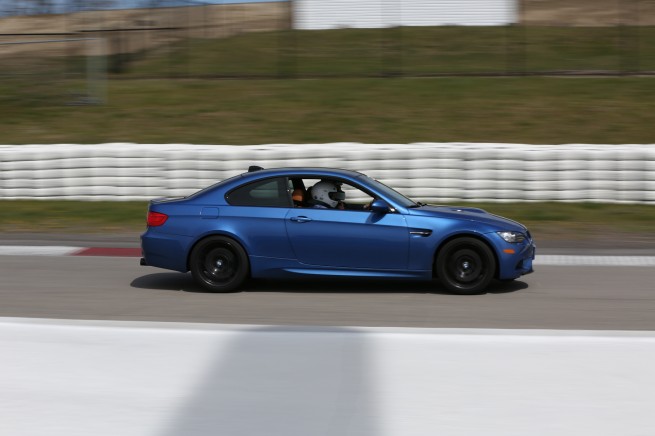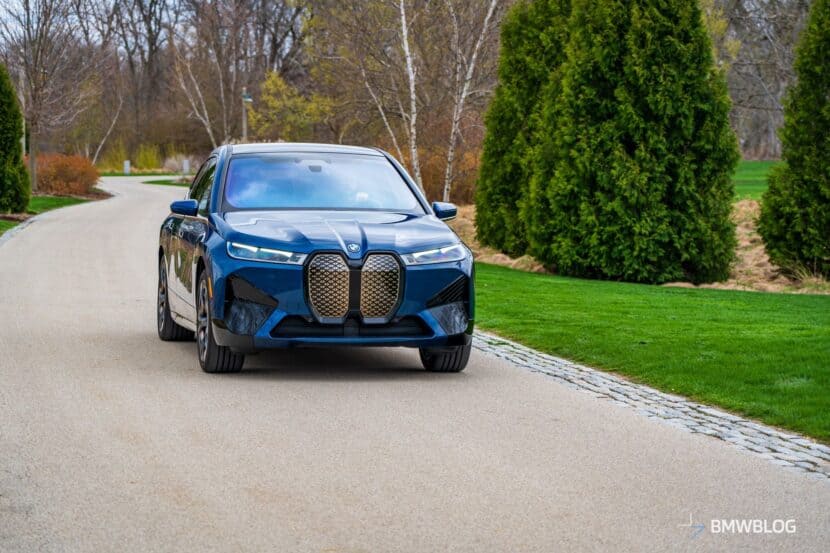Every track has a learning curve, but Mosport has a learning wall. I recently caught up with Bill Auberlin and Joey Hand at this year’s Mosport ALMS race and both drivers shared the same sentiment: Mosport is downright hairy, and sometimes scary.
It has the type of elevation changes that weight and unload a chassis, the type of high-speed corners that benefit from aero downforce, or at least reduced lift, a long up-hill back-straight that challenges engines, and a couple of braking zones that torment rotors. Mosport is, unequivocally, North America’s highest speed racetrack. For several years Mosport raceway – now badged Canadian Tire Motorsport Park under new ownership – has provided BMWBLOG the ideal proving grounds to test the true dynamics of BMW cars and SUVs. I suppose it is in some measure Canada’s Nurburgring – minus the castle and great length (so… it’s not really – but that sounds cool). Suffice it to say that Mosport is BMWBLOG’s home proving ground and playground and after putting in so many laps both wet and dry, we affectionately call it home.
Of course, we’ve tested more than BMW metal around this retired Formula 1 circuit. Late this summer I strapped into a shiny new Nissan GTR to set a new benchmark for lap time and trap speed. BMWBLOG met Godzilla, as she’s so aptly been named.
I write this racetrack review for BMWBLOG for two key reasons: to draw comparisons between Nissan’s AWD system and BMW M’s XM AWD system; secondly to ponder the success of Godzilla, and where BMW’s M3 slots in by way of competition.
Nissan’s GTR is a magnificent piece of automotive engineering. It is the stuff that NASA takes note of. Seemingly physics defying feats of performance are packed within. Consider the GTR’s hefty curb weight of 3,829 lbs and then stew over its 2.7 second 0-60 time as per Motor Trend. With 542 hp on tap and 463 lb-ft at the ready, the numbers just don’t add up. It shouldn’t be this fast.
Plenty of exotic engineering lies beneath – which we’ll get to in due time – but to strike at the heart of the matter, it’s the Nissan’s brilliant AWD system that enables its otherworldly performance.
And what an AWD system it is. To achieve its 54:46 front-to-rear weight distribution, the front-engined GTR has its dual-clutch transmission placed at the back of the car, housed within the transfer case along with the rear differential, thus rendering it a rear transaxle. We’re already into racecar design territory, but there’s more.
Nissan borrowed a page from the Porsche playbook to beat them at their own game. Indeed the GTR is a chubby 330 lbs heavier than the Porsche 911 Turbo S, yet it trounces it around any racetrack.
While designing the GTR, Nissan engineers paid homage to Porsche’s advanced 959 early-era supercar AWD layout. Power transfer starts, as always, at the driveshaft, which sends power from the engine to the rear gearbox, which in turn sends power to the rear wheels through a continuously electronically adjustable mechanical limited slip differential. Cleverly and compactly placed within the dual-clutch gearbox is a transfer case which uses a wet multi-plate clutch pack to transfer power to the front wheels via a separate drive shaft running power back up to the front of the car where it is distributed through an open differential to the front wheels.
The GTR is able to vector torque side to side between its rear wheels by way of its LSD, and by braking the opposite wheel accordingly, it can also vector torque side to side between its front wheels. The transfer case can distribute power between the front and rear axles anywhere from 2% front, 98% rear to a maximum of 50% front, 50% rear and it can alter the power distribution between all four wheels within milliseconds.
The mechanical layout of the drivetrain is advanced and unique among current production supercars. Its abilities boil down to advanced electronics applied on top of brilliant, complex mechanical engineering. The GTR’s AWD system has its own dedicated ECU, which gathers information from a 3-axis G meter, all ABS sensors, the gearbox and engine ECU sensors, steering wheel position and throttle position sensors to interpolate data and devise an AWD action plan. The AWD system then divvies up power as it believes you need it and carries on channeling all 542 hp to the ground.
That’s a mouthful, but I’m touching the tip of the iceberg. The materials used are also exotic. Both driveshafts are made entirely of carbon fiber – borrowed from an F1 car. The hood, trunk, doors and shock towers are made of aluminum to save weight. The turbine housings of the V6 engine share their castings with the exhaust manifolds to create a single, stronger, lighter unit. Even the door handles are made of aluminum to save weight.
The GTR’s DCT is operated through two thick-gauge magnesium paddles mounted as they ought to be: on either side of the steering column – left for downshift, right for upshift. They feel hefty as you clunk through each gear, offering up rifle-action precision that’s pleasing to your fingers. Shifts are accomplished in 200 milliseconds – which in today’s supercar circle is rather slow. Consider Porsche’s leading “PDK” dual-clutch shifts cogs in as little as 8 milliseconds. The shifts feel fast nonetheless and are incredibly smooth even when completing gear changes at full-throttle without lifting.
The GTR’s engine may not seem too exotic until you consider its potent 143.4 hp/liter specific power output. Sure, V6s aren’t too sexy (yet: once F1 moves to turbo-V6 engines I suspect the gorgeous ladies and flowing champagne might change our minds), but this one is exquisite even to look at – its twin turbo, twin intercooler layout bulges out from the engine bay with the hood open. The GTR’s V6 measures 3.8 liters in displacement and is placed almost perfectly over the front axles, sitting on the fence between a front-engined and front-mid engined layout.
Thanks to advanced valvetrain, ignition, intercooling and turbo technology, the GTR has virtually no perceptible turbo lag. Throttle response is epic and instant, as far as turbos go. No matter the gear, a twitch from my toe resulted in a tug from the wheels, with virtually no hesitation. This engine feels awfully hyper – I was left wondering if someone poured in a RedBull when I wasn’t looking.
The Nissan GTR also sports advanced aero, with a flat carbon-fiber underbelly to reduce lift and clever skin that cuts cleanly through the air, reducing drag. It may not be pretty, but you can’t dispute it’s functional. And in our world, form must follow function – so we’ll forgive the GTR’s pug face for the face it puts on your passenger.
Hauling the party back down to speed are 15.35 inch front rotors clamped by 6 piston calipers; 4 piston calipers bite down on 15 inch rotors at the back, all compliments of Brembo. The brakes on the GTR are terrific, withstanding the heft of the car well, braking zone after braking zone – though after sustained hot lapping some brake fade is noted. Given this car’s racer trap speeds and acceleration, it – of all cars – is deserving of a more aggressive carbon ceramic brake package.
So: Godzilla goes, stops and turns with heroic might, looks mean and at a base price of $97,820 USD, isn’t too expensive. Does it have any downfalls?
For starters, that ragging-bull engine is awfully thirsty – it turns in EPA figures of 16 city mpg, 23 highway mpg, 19 mpg combined. These figures are rather optimistic in my experience, though I did have a hard time laying off the throttle (who wouldn’t?!).
Second is operating costs – petrol aside. Okay, the purchase price offers bang for the buck – but maintenance costs and consumables will bankrupt you unless you’re well-heeled. This is not a popper’s track toy. Godzilla eats tires for snack time and has an appetite for brake rotors and pads. Nissan engineers have seemingly defied physics, but they haven’t escaped them. They have made a deal with the maintenance devil, and if you drive your GTR as it ought to be driven, you will know your parts supplier on a first name basis – and you may as well open your own tire and rotor recycling company. Throwing all that weight around with such vengeance comes at a price, after all.
Third is its character. “What?!” you exclaim, “How could that be? You’ve just gone on about this car’s greatness for pages and ages!” True, I have a lot of positive comments to lay before you, but Godzilla’s greatest downfall was felt from behind the wheel. Allow me to explain through a lap of Mosport.
The GTR I drove was fitted with a racing bucket and 5 point harness. After getting belted in I pulled first gear and slowly lumbered down pit lane. My copy of Godzilla was also fitted with Nitto R-compound track tires and upgraded brake rotors and pads, so job number one was putting heat in my equipment. After poking and prodding at her for a lap, it was time to fully unleash this beast. Blessed with a warm, sunny day, it didn’t take much to bring the tires and brakes up to temperature. Full-throttle up the front straight I breathed on the brakes to ease the car through corner 1, a tricky blind-apex corner where the track drops away from you, reducing your grip. In most cars it is important to gently ease back onto the throttle through corner 1, but Godzilla claws at the track with all four wheels, allowing you to get on the throttle more aggressively without repercussion.
Turn 2 separates the men from the boys with its fast, sweeping radius, downhill unweighting of the chassis, blind apex, changing camber, concrete strip, and shoulder marbles. This corner is not to be trifled with. While taking turn 2 at speed you are acutely aware of chassis weight transfer and a gentle four-wheel drift ensues if taken correctly. If this track were a rollercoaster, this is the corner where you’d put your hands in the air. It’s fun. But I strongly suggest you keep both hands on the wheel – their diligence is critical. At corner exit Godzilla was doing 190 kph. This is the quickest I’ve ever taken this corner. And lap after lap, the speed built, free of drama.
A friend asked if he could strap in to get his jollies and experience the performance envelope of the GTR. Entering corner 2 we came upon an E36 M3 and had to back off – but it was too late – it seems Godzilla scared him. Shortly after arriving in his review mirrors the M3 rotated and the driver failed to counter-steer effectively, meeting the inside wall head-on. Godzilla is a ruthless animal, a fearsome creature. It, apparently, takes no prisoners.
Corner 3 requires a shallow entry as you early apex, since this corner has an increasing radius – you get on the brakes early and then build speed to exit. The monstrous power of the brakes was impressive, hanging me from my 5-point harness. Then back on the throttle Godzilla claws away at the track surface, all four tires howling in masochistic delight. Corner 3 is a corner that typically requires patience, lest you induce understeer by getting on the throttle too early and push wide. But Godzilla gnaws away at corner 3 with zealous ambition, just point and shoot with wheel and pedal. The typical feathering of controls is redundant here, the genius on-board computer channels instructions to the complex AWD system and the GTR pulls you through arcade-style.
Corner 4 is similar to Corner 2, it’s another blind-entry fast left-handed downhill sweeper. If you need to find God, I encourage you to get acquainted with this corner, at speed. The brave merely lift off throttle at entry – the insane stay flat-out. This corner requires faith. Faith that the track will still be there as you fly blindly over the crest at entry, pointed slightly toward the apex. Faith that your machine will grip as it did last lap, carving a path down the hill to turn 5.
The magic of turn 5 lies in its heavy braking zone, which blends in from the exit of corner 4. The track aggressively rises over 30 feet at the entry to corner 5, so you’ll find heaps of traction as the car weights into the road and the tires are heavily mated to the track surface. You can positively stand on the brakes here and not break traction in a well sorted machine. Corner 5 is the slowest corner of the track, taken in second gear in most cars, or third in those with plenty of torque or shorter gear ratios.
Corner 5 is split into two sections, 5A and 5B – though if taken correctly you can make corner 5 a single apex corner. 5B illicits understeer as you try to swing the nose toward Mosport’s long back-straight. This tight right-hander normally requires fine finesse behind the wheel, working the controls to solicit a clean rotation. The typical management of weight transfer, flicking of the nose and throttle modulation is torn up, thrown in the air, lit on fire and then pissed on by Godzilla. Taking corner 5 in anger was an eye-opening experience. The GTR reads your thoughts. It knows what you want and need to do… just before you do it. It’s almost creepy. Before I could work at the wheel and play with the pedals Godzilla cancelled all understeer and whipped the nose toward corner exit. This marvel of automated driving dynamics was mind-blowing. I’ve never witnessed anything like it. Ever.
And now, it’s time to strain your neck again. Winding out through 3rd gear you pull the right paddle and grab 4th. The GTR hunkers down and leaps forward, the speedometer climbing relentlessly toward its stop-pin. 5th gear, you’re still glued to your seat. Into 6th gear briefly and this animal is still hell-bent on reversing time. My eyes were keenly observing corner entry to turn 8 and I dared not divert my attention, but my passenger confirmed a speedometer-read top speed of 262 kph on Mosport’s uphill back straight. This is quicker than I’d ever gone by a margin of 20 kph. Godzilla officially blew my mind.
The GTR’s relentless grip made quick work of the 8-9-10 complex, and I was once again on the front straight, charging up to corner 1, the V6 swooshing and hissing, growling and roaring to the delight of bystanders lined along pit wall. The GTR is a visual spectacle of speed – you naturally appreciate its dynamics because your eyes’ extrinsic and intrinsic muscles are given a work out – forced to move quicker as it passes by.
In short: Godzilla demolished Mosport. It reigned in what is usually a monster in its own right. The GTR is by far the fastest road car I’ve ever driven. It felt faster overall than BMW’s S1000RR sport bike – and depending on the track, the GTR actually is faster. I remember the ripping acceleration of the S1000RR when taken full throttle through its first 4 gears, and Godzilla doesn’t feel far behind – in fact this car keeps up with Bugatti’s Veyron up to 100 kph.
Clearly, the GTR is a very special car, requiring heaps of respect and deserving nods of appreciation. I tell you, after parking Godzilla in the paddock, on fumes, the tires sticky – picking up bits of gravel and sand, the brakes smoking, I was hesitant to walk away. I wanted to re-study its shape. I wanted to take in the details, hoping I’d find further clues to its performance. The GTR is awe-inspiring. But I also stood contemplating the experience. Yes, the speed was there, but was the challenge and emotion? For the first time while lapping Mosport, I felt utterly redundant, and replaceable. Nissan had out-smarted my hands and feet, clasping differentials, grabbing brakes, retarding ignition and spinning turbines a fraction of a second before I could react. This car out-drove me. And it was a little bit sad.
While I still stand in awe of the engineering achievement that is the Nissan GTR, I also stand utterly disappointed by its lack of driver involvement. If ever there was an arcade-style real-life driving experience, this is it.
For me, the joy of driving comes from overcoming obstacles, and rising to challenge. It comes from honing my skills and learning finer finesse of the controls. I’m taken to an automotive nirvana when I can calm myself and lower my pulse as the pace quickens. This is the magic of driving. Godzilla steals this from me while hurling me around at ungodly speeds. It’s like driving a big computer with wheels. It’s fun for a few laps – horizon expanding and eye-popping. But then the high wears off and you’re left with a four-wheeled computer.
I’ve driven Mosport in much slower, more engaging cars. They are not more engaging because they’re slower, but rather because they place you squarely responsible for cornering dynamics. They require a finer touch, a kiss of control. They make you part of the machine, not a glorified passenger.
I’ve never gone around Mosport quicker, nor come upon so much traffic – moving chicanes, if you will. And I probably never will lest I land a race seat, and I’m not holding my breath – I’ve long missed that boat; besides, I was born too tall and heavy. I’ll cherish my laps in Godzilla, but for purely academic reasons. I’ve had more fun in a rear wheel drive BMW with one-third the horsepower.
Now, to the purpose of this review as highlighted at the outset: the consideration of how BMW M’s AWD system compares to Nissan’s, and what sort of competition the M3 offers up to the GTR?
You have to wonder how the X6M and X5M hurl themselves to speed with such urgency and grace. They, like the GTR, also seem to defy physics, laden with over 5,300 lbs of heft. Like in the Nissan, the answer also lies, largely, in BMW’s advanced AWD system. Unlike the GTR, the XM cars use more traditional AWD hardware, but they use this hardware with flawless precision. Power is proportioned front to rear as needed, and shifted within fractions of a second based on advanced calculations by the ECU, including data from the throttle position to the steering wheel angle, differing wheel speeds, yaw rate and G loading. The complex rear E-Differential then vectors torque side-to-side between the two rear wheels as needed to hurl the XM cars out of corners with excellent traction. The front diff is open, but the XM cars do not seem to suffer for it from behind the wheel. Understeer is nicely mitigated, oversteer is tamed, and the XM cars go on to trounce sports cars half their weight.
BMW M’s AWD system is nowhere near as advanced or exotic as Nissan’s, what with their carbon-fiber drive shafts and complex rear transaxle harkening back to the ultra-exotic Porsche 959 supercar, but it is effective, turning this heavy SUV into a worthy track toy.
BMW’s M3 offers no dynamic competition to the GTR. The GTR simply resides in another performance stratosphere – firmly in supercar territory. But the M3 does offer emotional competition to the GTR as its playful handling and tendency toward power-slides puts a smile on your face – time and again. The M3 is an instrument of driving, a sharp tool in the hands of a willing driver. It’s capable of dancing with you through corners, its rear wheels painting a Da Vinci of performance driving whilst leaving thick black lines etched in the track surface.
In conclusion: Driving the GTR is science. Driving the M3 is art.






















































































